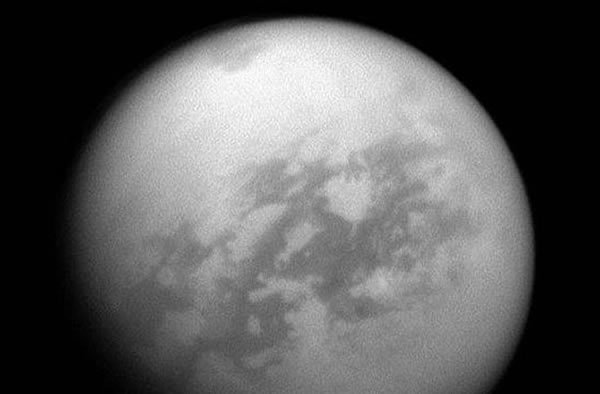Titan Wrapped in Thick Ice
An infrared image of Titan from the Cassini orbiter.
At first glance, Saturn's large moon Titan is an Earth-like world, with atmosphere, weather and even lakes, though these contain liquid ethane and methane, not water.
But appearances can be deceiving. New results from NASA's Cassini spacecraft show Titan has an icy shell far more rigid and thicker than previously believed.
"The ice is much stronger than anyone expected," Doug Hemingway, a planetary sciences doctoral student at the University of California Santa Cruz, told Discovery News.
The findings, based on Titan gravity measurements, do not bode particularly well for the moon's life-hosting potential.
Scientists believe Titan harbors a global subsurface ocean, but it is cut off from the surface by a rigid sheet of ice as thick as about 62 miles -- 10 times stronger than previously thought.
"It's good if you have some way of moving material from the top of the ice shell down to the ocean and then back up," like on Jupiter's moon Europa, planetary scientist Francis Nimmo, also with University of California Santa Cruz, told Discovery News.
"That makes a place more habitability and it also gives you a better chance of detecting things," he said.
On Titan, "it's hard to envisage a way of transferring material through 100-kilometers' worth of rigid ice down to the ocean, or from the ocean back up to the surface," Nimmo said.
The Cassini measurements show that areas of higher elevation on Titan have weaker gravity fields than lower-lying regions, which Hemingway and colleagues say is only possible if the moon’s surface ice is extremely rigid and highly eroded.
"The surface looks really very like the Earth ... but at the same time, it's not geologically active in the same way that the Earth is," Nimmo said.
"On the Earth you are continually building up mountains and then you're carving them away with erosion. On Titan, you have the erosion and the weather, but I don't think you have mountain-building in quite the same way. It's a very odd combination," he said.
The research appears in this week's Nature.(Aug 28, 2013 01:00 PM ET // by Irene Klotz)












